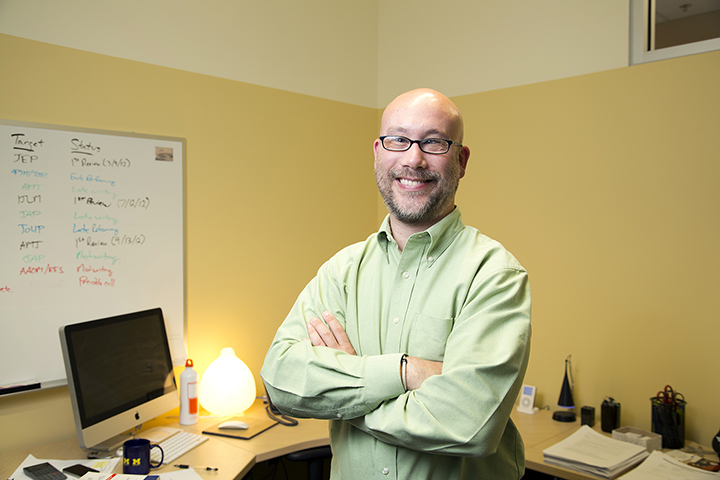Greg Laurence, Ph.D.
Assistant Professor of Management
(Article by Kim Laux)
Feeling uninspired or emotionally exhausted at work lately? Maybe it’s because your workspace doesn’t have the right amount of “you” in it.
According to research conducted by Gregory A. Laurence, Ph.D., assistant professor of management at UM-Flint, the items we use to decorate our workspace (awards, photos, posters, knick-knacks and artwork) play a significant role in our ability to connect with our co-workers and clients, manage our emotions and achieve our goals.
“The most important take-away from this study is a deeper understanding of why people decorate their workspaces and how it impacts their experiences at work,” Laurence explained. “Where past research looked closely at personalization as a way of expressing identity, we explore how it affects relationships, emotions and professional goals.”
Laurence explained how several people interviewed for the study said that they chose to display items in their workspace that they expected people to question them about.
“This tells us that personalization can be used as an icebreaker, and helps to build relationships between colleagues and clients. Many participants also discussed choosing certain photos, posters and objects that would cheer them up, inspire them, or remind them of why they work,” said Laurence. “For example, one interviewee described hanging a poster in her workspace that was suggestive of the type of designs she wanted to create, another kept a clock that reminded her of a mentor who she wanted to emulate, and a third kept a hand-carved mouse she had received from a client as a reminder to always strive to provide good customer service.”
The research was the basis for Laurence’s recent article, “Diplomas, Photos, & Tchotchkes as Symbolic Self-Representations: Understanding Employees’ Individual Use of Symbols,” co-authored with Kris Byron, Ph.D, chair of the Department of Management at Whitman School of Management at Syracuse University. Accepted for publication in late January, 2014, the paper will appear in the Academy of Management Journal.
“Workspace personalization is far more complex and beneficial to individuals and organizations than we previously realized,” said Laurence. “Freedom to express one’s self through particular symbols in the professional environment serves a purpose in employees’ relationships at work and can inspire them to achieve more of their goals. The research tells us that in the interest of employee performance, organizations should avoid placing heavy constraints on how people customize their cubicles and offices.”
This closer examination of personalization grew out of one of Laurence’s earlier studies, “‘My space’: A moderated mediation model of the effect of architectural and experienced privacy and workspace personalization on emotional exhaustion at work,” published last summer in the Journal of Environmental Psychology, and cited in an article in O, The Oprah Magazine (January, 2014). This earlier study uncovered that while employees working in offices (four opaque walls and a door) experienced less emotional exhaustion than those working in less private spaces, workspace personalization significantly reduced burnout among workers situated in low privacy contexts like cubicles.
In the “O” article, Laurence was quoted, “…personalization allows workers to regain a sense of privacy and control of their environment. You’re saying to coworkers, This is what I want you to know about me, and that autonomy, no matter how small, appears to reduce burnout.”
